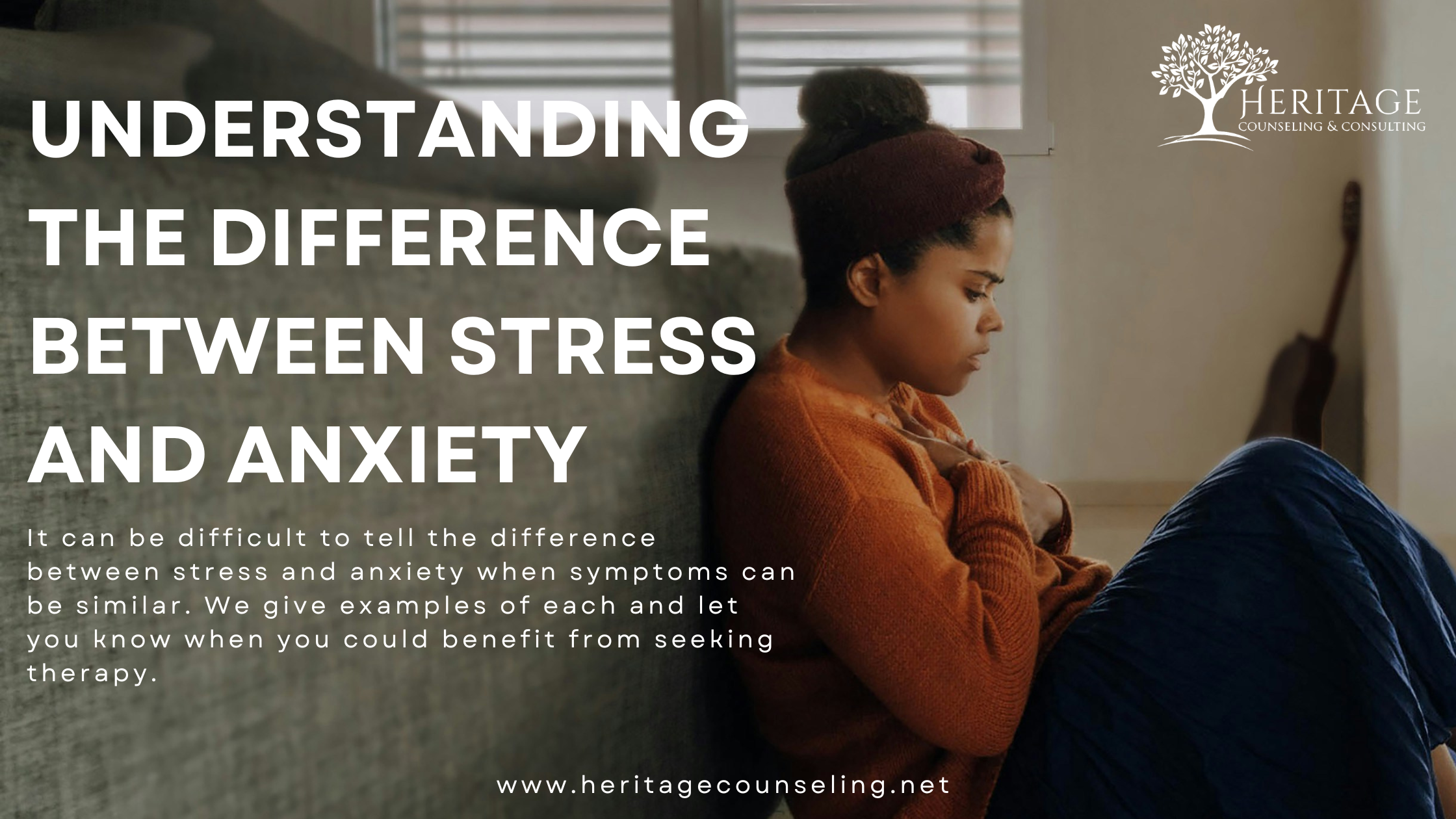In today's fast-paced and interconnected world, stress and anxiety have become prevalent issues affecting millions of people worldwide. The modern lifestyle is characterized by constant demands, high expectations, and an ever-increasing pace of life, all of which contribute to heightened levels of stress and anxiety. The prevalence of stress and anxiety in modern life can also be attributed to a combination of factors including societal pressures, technological advancements, and unhealthy lifestyle habits. Recognizing these factors is crucial in addressing and managing stress and anxiety effectively in today's society; however, the difference between the experience of stress versus anxiety can be confusing and needs clarity. The terms "stress" and "anxiety" are often used interchangeably, but they represent distinct experiences that have different implications for our mental and physical well-being.
Defining Stress
Stress is a natural response to external pressures or demands, often referred to as stressors. These stressors can be real or perceived and may include situations such as work deadlines, financial pressures, relationship conflicts, or major life changes. Stress is often short-term and caused by a recognized threat. While stress is a normal part of life and can sometimes be beneficial in motivating us to take action, chronic or excessive stress can have negative effects on our physical and mental health.
Understanding Anxiety
Anxiety, on the other hand, is a persistent and excessive worry or fear about future events or situations. Unlike stress, which is typically tied to specific stressors, anxiety often lacks a clear trigger or may be disproportionate to the actual threat posed by a situation. Some amount of anxiety is a normal reaction to stress.
Anticipation and dread play significant roles in anxiety, often exacerbating its symptoms and impact on individuals' lives. Anticipation involves looking forward to or anticipating future events or situations, while dread refers to a sense of impending doom or fear about what may happen. Both anticipation and dread can contribute to the cycle of anxiety in several ways including heightened sensitivity, cognitive distortions, physical symptoms, ruminations, and avoidance behaviors.
While stress is usually temporary and tied to specific stressors, anxiety can be ongoing and pervasive, affecting various areas of life. Generalized Anxiety Disorder (GAD) is a common anxiety disorder characterized by excessive worry and anxiety that persists for at least six months and interferes with daily functioning. According to the latest data from the National Institute of Mental Health, 31% of Americans will experience an anxiety disorder during their lifetimes.
Signs and Symptoms of Stress
Stress can manifest in various physical and emotional signs, and individuals may experience a combination of these symptoms. Here are some common physical and emotional signs of stress:
Physical Signs:
Muscle Tension: Stress can cause muscles to tense up, leading to headaches, neck pain, back pain, and overall body stiffness.
Fatigue: Feeling tired or exhausted even after a full night's sleep is a common sign of stress.
Sleep Disturbances: Stress can disrupt sleep patterns, leading to difficulties falling asleep, staying asleep, or waking up feeling unrested.
Digestive Issues: Stress can affect the digestive system, leading to symptoms such as stomach pain, bloating, diarrhea, constipation, or nausea.
Changes in Appetite: Stress can alter appetite, leading to overeating or undereating, which may result in weight gain or weight loss.
Increased Heart Rate: Stress activates the body's fight-or-flight response, causing the heart to beat faster and blood pressure to rise.
Breathing Difficulties: Stress can lead to shallow or rapid breathing, chest tightness, or shortness of breath.
Weakened Immune System: Chronic stress can suppress the immune system, making individuals more susceptible to infections and illnesses.
Emotional Signs:
Anxiety: Feeling anxious, nervous, or on edge is a common emotional response to stress.
Irritability: Stress can make individuals more easily frustrated, agitated, or irritable in response to minor irritations.
Mood Swings: Stress can cause fluctuations in mood, leading to mood swings ranging from sadness and despair to anger and frustration.
Difficulty Concentrating: Stress can impair cognitive function, making it challenging to focus, concentrate, or remember things.
Feelings of Overwhelm: Stress can make individuals feel overwhelmed or overloaded by responsibilities, tasks, or obligations.
Sense of Loss of Control: Stress can lead to feelings of helplessness, powerlessness, or a lack of control over one's circumstances.
Low Self-Esteem: Stress can negatively impact self-esteem and self-worth, leading to feelings of inadequacy or self-doubt.
Social Withdrawal: Stress can cause individuals to withdraw from social interactions, preferring to isolate themselves from others.
Stress responses, often associated with feelings of discomfort or distress, actually serve a vital adaptive purpose in certain situations. The stress response, also known as the "fight-or-flight" response, is a physiological reaction triggered by perceived threats or challenges. While chronic or excessive stress can have negative effects on health, in certain contexts, stress responses can be adaptive and beneficial. By activating physiological, cognitive, and behavioral responses, stress responses help individuals cope with threats or challenges, promote survival, and facilitate learning and adaptation. Understanding the adaptive nature of stress responses can help individuals develop effective coping strategies and harness the positive aspects of stress to navigate life's challenges more effectively.
Signs and Symptoms of Anxiety
One of the biggest differences between stress and anxiety is the lack of a specific trigger. Once a specific stressful situation is resolved, oftentimes, so goes the stress response. Anxiety can linger and not necessarily have an identifiable cause. Along with the marks of stress, anxiety may come with additional distressing features including:
Excessive Worry: Persistent and uncontrollable worrying about various aspects of life, including work, relationships, health, or future events.
Irrational Fears: Experiencing irrational or disproportionate fears about specific objects, situations, or activities, such as fear of heights, spiders, or social interactions.
Emotional Symptoms: Emotional symptoms of anxiety often include those of stress but add feelings of dread or a sense of impending doom.
Pervasive Avoidance Behaviors: Individuals with anxiety may engage in excessive avoidance behaviors to cope with their fears or discomfort, such as avoiding certain places, activities, or social situations that trigger anxiety.
Anxiety can have a significant impact on daily functioning in multiple domains of life. Anxiety can hinder cognitive function, leading to difficulties concentrating, making decisions, or performing tasks effectively at work, school, or in daily activities. It can strain relationships and social interactions, causing communication breakdowns, withdrawal from social activities, or conflicts with others due to heightened stress levels. Chronic and severe anxiety may lead to absenteeism from work or school due to challenges managing symptoms or feeling overwhelmed by responsibilities, impacting productivity and academic performance.
Recognizing Red Flags
Recognizing when stress or anxiety is evolving into a more significant mental health concern is crucial for early intervention and effective management. While occasional stress and anxiety are normal, persistent and intense symptoms that interfere with daily life may indicate a more serious problem. This includes constant worrying, panic attacks, or overwhelming feelings of fear or dread. Chronic physical symptoms may also indicate that stress or anxiety is taking a toll on both mental and physical health. While occasional avoidance behaviors are normal, engaging in excessive avoidance to cope with stress or anxiety, such as avoiding social situations, responsibilities, or activities that trigger anxiety, can indicate a worsening condition.
Increased reliance on substances such as alcohol, drugs, or prescription medications to cope with stress or anxiety may indicate the need for professional help. Persistent thoughts of self-harm or suicide, or engaging in self-destructive behaviors, are serious warning signs that require immediate attention and intervention, including potential emergency services.
Self-awareness is essential in recognizing these signs and taking appropriate action to address them. It involves paying attention to one's thoughts, feelings, and behaviors, as well as being open to feedback from trusted friends, family members, or healthcare professionals.
When Should I Seek Counseling?
Ultimately, the decision to seek counseling for stress and anxiety is a personal one, and there is no one-size-fits-all answer. However, if stress and anxiety are impacting your quality of life and ability to function effectively, seeking support from a trained therapist or counselor can be an important step towards healing and recovery. In counseling, individuals work to identify triggers and patterns that contribute to their anxiety. By understanding the specific situations, thoughts, and behaviors that exacerbate anxiety symptoms, individuals can develop targeted coping strategies to manage their anxiety more effectively.
Cognitive-behavioral therapy (CBT) is a widely used approach in counseling for anxiety. CBT focuses on identifying and challenging negative thought patterns and beliefs that contribute to anxiety, replacing them with more adaptive and realistic thoughts. Therapists teach individuals practical skills and techniques to manage anxiety symptoms, such as relaxation exercises, mindfulness, and problem-solving strategies. Exposure therapy is another effective technique used in counseling to treat anxiety disorders, particularly phobias and obsessive-compulsive disorder (OCD). Exposure therapy involves gradually exposing individuals to feared situations or stimuli in a controlled and supportive environment, allowing them to confront their fears and learn that they can tolerate and manage anxiety-provoking situations.
Counseling helps individuals develop stress management skills to reduce the overall impact of stress on anxiety symptoms. Therapists may teach relaxation techniques, such as deep breathing, progressive muscle relaxation, or guided imagery to help individuals calm their minds and bodies in times of stress. Counseling provides a safe and supportive space for individuals to explore the underlying factors contributing to their anxiety, such as past experiences, trauma, or unresolved emotions. By gaining insight into these underlying issues, individuals can begin to address them and reduce their impact on current anxiety symptoms.
In conclusion, there are several key distinctions between stress and anxiety. Stress is a natural response to external pressures or demands, while anxiety is a persistent and excessive worry or fear about future events or situations. Stress is typically tied to specific stressors and is often short-term, while anxiety can be ongoing and pervasive, lacking a clear trigger or may be disproportionate to the actual threat posed by a situation. Stress can cause physical symptoms such as muscle tension, fatigue, and headaches, while anxiety may also present with physical symptoms but is often characterized by heightened arousal, irrational fears, and a sense of dread.
Heritage Counseling Can Help
At Heritage Counseling, we specialize in stress management and anxiety counseling, providing personalized treatment plans tailored to your unique needs. Our therapists have extensive training and expertise in helping individuals navigate the complexities of stress and anxiety.
We offer a range of therapeutic techniques and evidence-based approaches to help manage stress and anxiety including Cognitive Behavioral Therapy (CBT), Mindfulness-based Techniques, Relaxation training, and Neurofeedback, a cutting-edge therapy that uses real-time brainwave monitoring to teach individuals how to regulate their brain activity. By providing feedback on brainwave patterns associated with stress and anxiety, Neurofeedback helps individuals learn to control their brain function, leading to reduced symptoms and improved emotional well-being.
It's crucial to be proactive in recognizing signs of stress and anxiety and seeking support when needed. If you're struggling with stress or anxiety, don't hesitate to reach out to Heritage Counseling at 214-363-2345 for support and guidance. Our team of compassionate and experienced therapists is dedicated to helping you overcome obstacles, develop coping skills, and lead a more fulfilling life. Take the first step towards healing by contacting Heritage Counseling today.
Sources:

